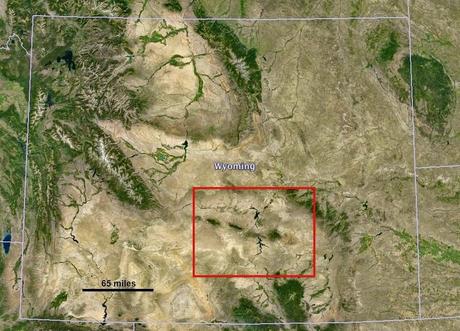 Google Earth view of the "Heartland of Laramide Tectonics" in south central Wyoming. Red rectangle encloses area of photo below. Click on images to view details.
Google Earth view of the "Heartland of Laramide Tectonics" in south central Wyoming. Red rectangle encloses area of photo below. Click on images to view details.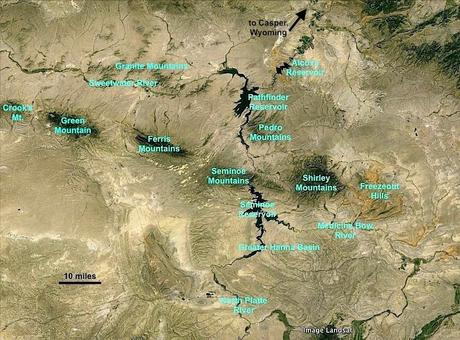
Last month I took a short tour of the Heartland of Laramide Tectonics. I had several geology guidebooks with me, so it was a fascinating trip. The timing was good too. If I had gone 75 million years earlier, it would have been really boring.
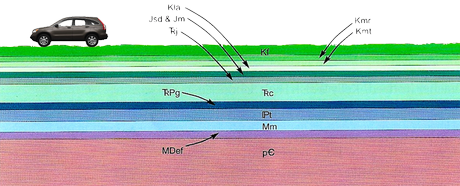
Traveling across south central Wyoming 75 million years ago.
At that time, the sea that had covered much of Wyoming for so long had retreated, leaving behind scenery of little relief. But then the land was folded. Now it’s a much more interesting place to visit.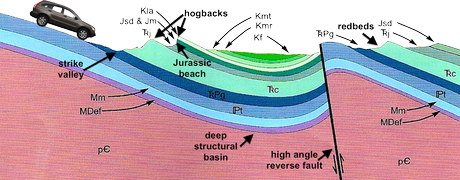
Traveling across south central Wyoming in 2014. Bold arrows point to selected attractions.
This folding happened during the Laramide Orogeny -- the period of mountain-building that produced the Rocky Mountains. Most of Wyoming is dominated by Laramide structures. They’re distinctive and usually easy to spot (it helps that the climate is semi-arid and vegetation often sparse).
Wyoming, with prominent Laramide mountain ranges in red; adjacent basins aren't labeled.
The creation of Laramide ranges and basins involved moving, tilting, folding and breaking (along faults) broad blocks of continental crust all the way down to basement rocks. What?! Is it possible to fold and break the basement of a continent? Is it safe?Basement (geology): rocks below a sedimentary platform or cover, or more generally any rock below sedimentary rocks or sedimentary basins that are metamorphic or igneous in origin.“Basement” is one of those terms we understand and use, but find difficult to define. Part of the problem is that usage varies by continent. In North America "basement" generally refers to igneous and metamorphic rocks of the craton -- the old stable part of the continent that has been around since Precambrian time. The North American craton underlies much of Wyoming.
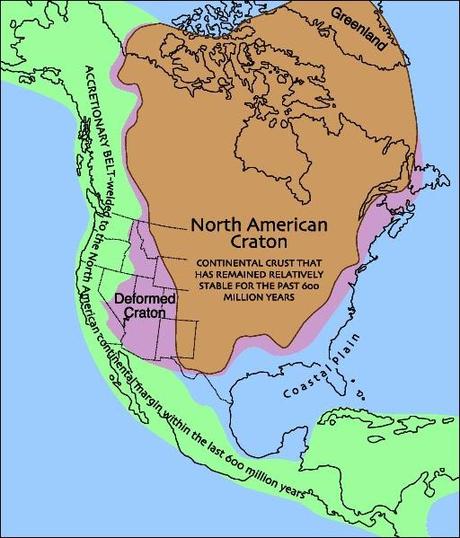
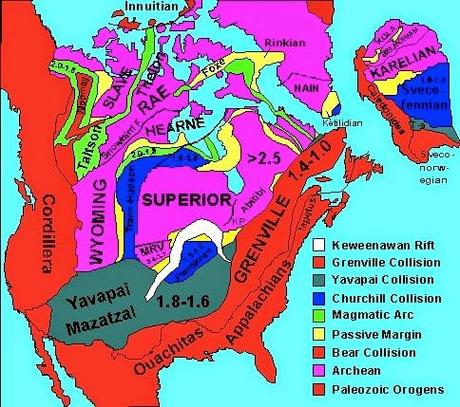
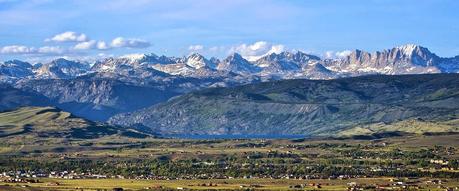
Basement rocks form the high peaks of the Wind River Range, east of Pinedale; source.
The Laramide Orogeny was a big event in both time and space. It lasted roughly 30 million years; start and stop times are debated and varied from north to south. A large part of western North America was deformed, from Canada south into Mexico. Actual Laramide-style deformation, involving basement rocks, characterized the tract from southernmost Canada to central New Mexico.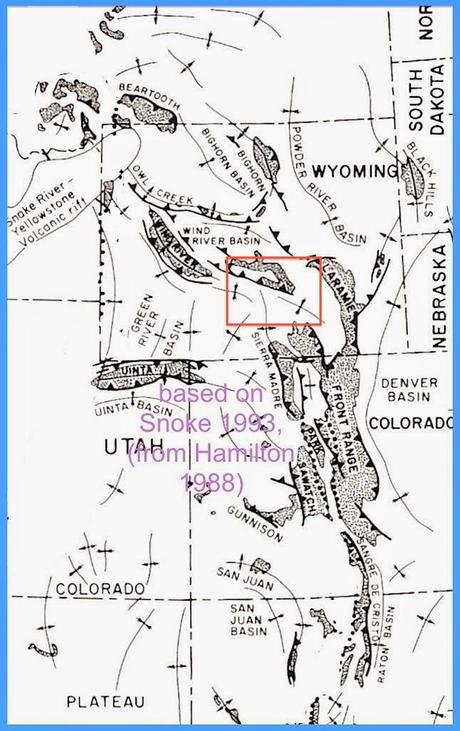
Extent of Laramide-style deformation, showing exposed Precambrian basement rocks (stippled); modified from Snoke 1993 (from Hamilton 1988). Heartland outlined in red.
The area around the North Platte, Sweetwater and Medicine Bow Rivers in south central Wyoming has been called the Heartland of Laramide Tectonics (Lillegraven and Snoke 1996). After my trip I asked one of the authors about the Heartland concept. He attributed it to the other’s propensity for colorful language, but also emphasized that the region is filled with exemplary Laramide structures.It certainly is a folded land. My trip crossed multiple folds and faults, passing through scenery made of rocks ranging from Precambrian basement to mid-Tertiary basin fill. Their stories are fascinating. It’s so wonderful that by looking at rocks and landforms we can glimpse past worlds ... 30 million, 100 million, even a billion years ago.
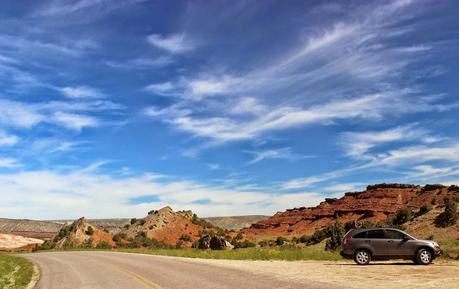
Small anticline reveals Triassic redbeds, deposited when much of Wyoming was a muddy coastal plain.
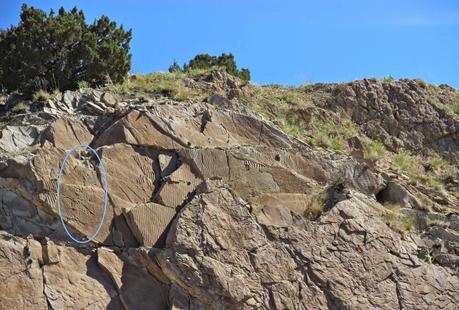
Who walked here 170 million years ago? Click on image to see tracks in beach sand turned to rock, and tilted to almost vertical.
Then there are the mysteries -- mountains flanked by steeply-tilted rocks on one side and a normal fault on the other, buried mountains, mountains crossed by rivers, and most puzzling, mountains far from any active plate boundary (where mountains usually arise). How did these things come to be? Sometimes we have a good idea, sometimes there are multiple theories based on the same incomplete evidence. And sometimes we just don't know, which is fine. This mystery adds to my sense of awe, and allows for informed speculation, a favorite pastime. I love looking at Laramide landscapes and pondering what might have happened.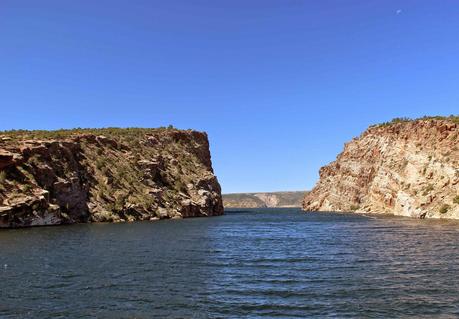
Water gaps were cut by the now-drowned North Platte River, as it made its way across Laramide folds (second gap visible in distance).

The gap and river before Alcova Dam was built in the 1930s. From the Collections of American Heritage Center, University of Wyoming, Copy and Reuse Restrictions Apply.
My tour began at Alcova Reservoir, where the North Platte has cut through the Alcova uplift instead of going around it. Much of the scenery is dominated by Permian and Triassic redbeds, in part because their color is so eye-catching. My guide was Knittel et al.’s Field guide for the Alcova area (2004), which provides lots of information, including explanations for non-geologists. The visuals are great -- maps, aerial photos, historical photos, photos with geologic features labeled, and panoramic shots. There’s even a tour up Fremont Canyon from Alcova Lake, if you have a boat. The road mileages didn’t match my car’s odometer, but that’s not so unusual and wasn’t a problem. A virtual guide provides additional labeled photos linked to map locations.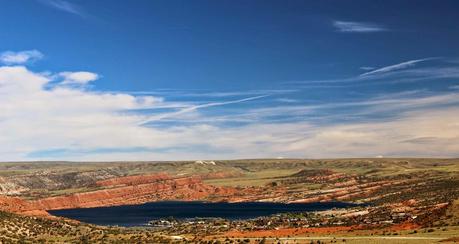
Alcova Reservoir amid tilted redbeds.
From Alcova I drove south to Fremont Canyon. Here the North Platte has cut through uplifted strata all the way down to basement rocks, revealing an intriguing gap in the rock record of some two billion years.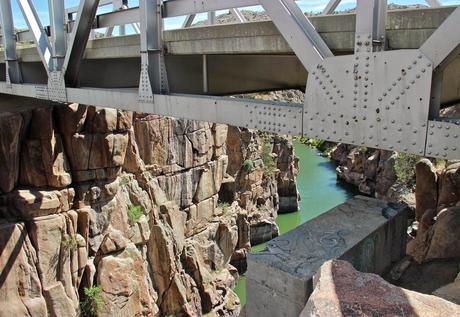
The Archean granite in Fremont Canyon above Alcova Lake is about 2.4 billion years old.
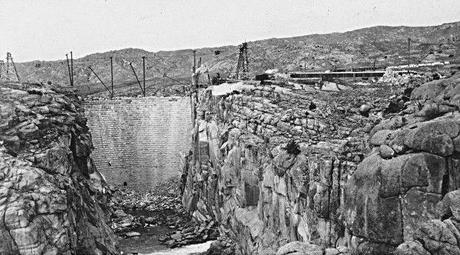
Pathfinder Dam was named for "The Pathfinder" -- JC Fremont. His boat capsized nearby.
Next stop was Pathfinder Dam, one of BuRec’s earliest (1905-1909). Then I crossed miles of Tertiary basin fill with Precambrian granite knobs sticking up through -- perhaps the most mysterious “mountain range” in Wyoming. I reached the south "flank" of the "range" at the amazing Seminoe Mountains -- steep dark foreboding rocks crossed by both the North Platte River and the county road. How improbable! I emerged at Seminoe Reservoir, with views of spectacular Laramide flatirons. This area is covered in A new look at the Laramide orogeny ... in southeast Wyoming, which includes several road logs (Lillegraven and Snoke 1996).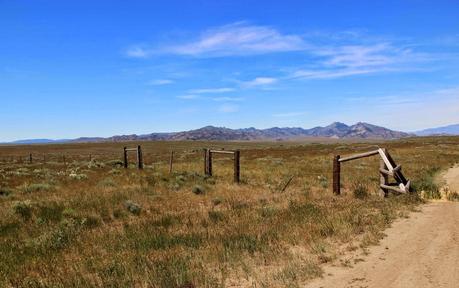 Above, the Pedro Mountains in the distance are Precambrian basement rocks that were uplifted, down-dropped, buried, and partially exhumed.
Above, the Pedro Mountains in the distance are Precambrian basement rocks that were uplifted, down-dropped, buried, and partially exhumed.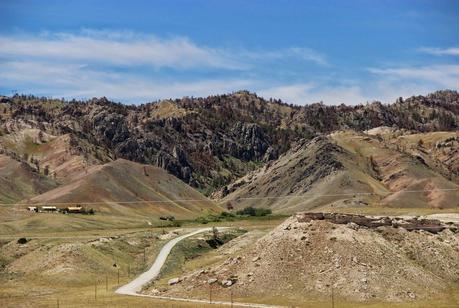 Above, approaching the north side of the Seminoe Mountains. Yes, the county road really does cross here ... so does the North Platte River, a short distance east. Below, looking north from the crest of the Seminoes down into the drainage of the North Platte. The river has eroded off enough Tertiary cover to reveal parts of the underlying Pedro Mountains.
Above, approaching the north side of the Seminoe Mountains. Yes, the county road really does cross here ... so does the North Platte River, a short distance east. Below, looking north from the crest of the Seminoes down into the drainage of the North Platte. The river has eroded off enough Tertiary cover to reveal parts of the underlying Pedro Mountains.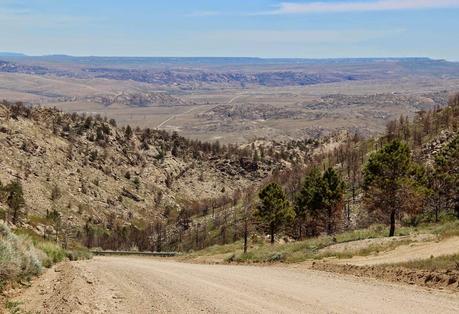 My tour of the Heartland of Laramide Tectonics ended on the south side of the Seminoe Mountains, where steeply-tilted sandstone and limestone flatirons made a nice backdrop for a portrait of a ruggedly beautiful limber pine (Pinus flexilis).
My tour of the Heartland of Laramide Tectonics ended on the south side of the Seminoe Mountains, where steeply-tilted sandstone and limestone flatirons made a nice backdrop for a portrait of a ruggedly beautiful limber pine (Pinus flexilis).
Posts about some highlights of the Heartland trip will follow.
Sources
Casper College. Alcova geological site 2008; Virtual field trip of Alcova Lake, and Fremont Canyon, Natrona County, Wyoming. Accessed July 2014.
Knittel, P, Van Burgh, Jr., DP, Logue, TJ, Strube, BE, and Jones, RW. 2004. Field guide for the Alcova area, Natrona County, Wyoming.Lillegraven, JA and Snoke, AW. 1996. A new look at the Laramide orogeny in the Seminoe and Shirley mountains, Freezeout Hills, and Hanna Basin, south-central Wyoming. Wyoming State Geological Survey Public Information Circular No. 36.Snoke, AW 1993. Geologic history of Wyoming within the tectonic framework of the North American Cordillera, in Snoke, AW, Steidtmann, JR, and Roberts, SM, eds. Geology of Wyoming. Wyoming State Geological Survey Memoir 5:2-56.
